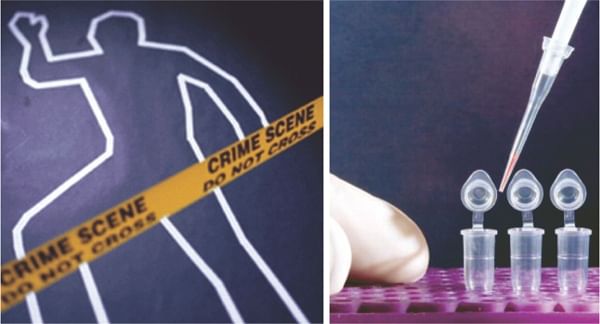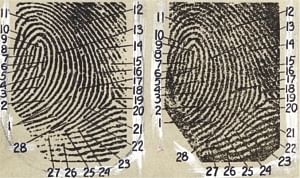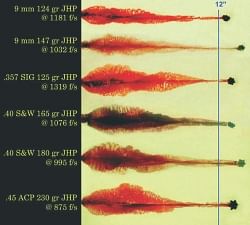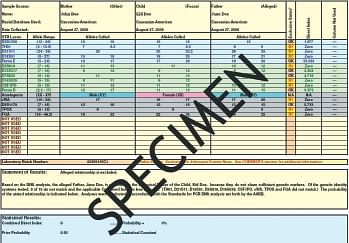| Home - Back Issues - The Team - Contact Us |
 |
| Volume 10 |Issue 28 | July 22, 2011 | |
|
|
Crime The Science Behind ANIKA HOSSAIN
Anyone who watches crime shows on TV, is familiar with the concept of forensic science. Although these shows serve to highlight the importance of the role of forensics in the detection of crime, this science is not a quick and easy way to solve crimes as these shows make it out to be. Forensic science can be very tricky. For those who are unfamiliar with forensics, it is the application of basic scientific techniques for the analysis of physical evidence associated with any crime. The existence of forensics dates back to prehistoric times, when fingerprints were used to identify rock carvings and early paintings made by the primitive man. In the year 700, the Chinese used fingerprints to identify documents and clay sculptures but they did not establish a formal classification system for these prints. Forensics was first used in the Roman courts to acquit a blind man in the year 1000, by Quintilian, an attorney who successfully proved that bloody palm prints were meant to frame this man for his mother's murder.
A Chinese book called His Duan Yu (the washing away of wrongs) published in the year 1248, contains a detailed description of how to differentiate drowning from strangulation. This was the first recorded application of medical knowledge, to the detection of crime. In modern times, forensic science has become an integral part of the process of crime detection and new aspects of forensics are being developed along with technology to support them. “Forensic evidence has been used to prove cases since the existence of criminal courts in Bangladesh”, says criminal lawyer Chaitanya Chandra Halder, “ But it is only in recent times, for the past five years, that forensic tests are being conducted in this country. Before that, all physical evidence was sent to Singapore for testing.” Forensics borrows techniques from various different disciplines such as Chemistry, Photography, Surgery, Biology, Mathematics, Physics and Medicine and forms a science of its own. If the tests are conducted with precision, this unbiased evidence can help answer questions regarding whether a crime has been committed, how and when it was committed and most importantly, who the culprit is. Forensic evidence is considered more reliable than eyewitness testimony because it is based purely on facts, it cannot be biased and it remains permanent and unchanging. “Eye-witnesses can be threatened or bribed,” says Halder, “We have seen this in many cases in Bangladesh. Of course, there are also cases where their memory may fail to serve them, depending on how long ago the crime occurred. Eye-witnesses often contradict themselves and change their stories.” Physical evidence however, will never tell a lie.
In order to ensure this, forensic scientists, otherwise known as criminalists (not criminologists) must lead extremely hazardous lives. Their jobs are very risky, as they often have to deal with firearms, ammunition, poisons, explosives, narcotics, blood, adulterated chemicals and much more. They may also have to visit crime scenes, which may be unsafe, depending on the nature of the crime. A proper forensics lab will consist of several departments, each dealing with a different kind of crime. A forensic physicist will generally examine the materials obtained from a crime scene. A physicist will also conduct comparative studies on various impressions left in the crime scene and marks of tools etc that may have been used in the crime. Forced engine marks and restoration of numbers and letters, which have been erased from a metallic surface and analysis of paints and glass particles, is also done in this department. The forensic chemistry department determines the purity of substances such as petrol, diesel, kerosene etc from samples. They also determine the quality of liquor, opium, and various narcotics and chemicals. They also examine explosives. Forensic biologists have the most interesting yet morbid job. They examine all biological material starting from microorganisms to plants and animals. They examine skeletal remains to determine the sex, ethnic origin, stature and age of the deceased. As shown on TV, they use the skull and superimpose features to determine what the deceased may have looked like, much like a sketch artist. The biologists also ascertain the cause of death from the remains of the deceased and in certain cases, given enough physical evidence, they can even determine the time of death. Forensic biologists can identify which poisons are used in a crime if the poison is extracted from plants. Serologists deal with crimes, which involve blood. They play a large role in murder cases where weapons such as knives are found, stained with blood. It is the Serologist's job to determine whether this is human blood and through DNA tests, determine the blood type and given the evidence, who it may belong to. Serologists also conduct DNA tests in disputed paternity cases. Next come the document experts, who determine whether a document has been forged, these range from wills, to property papers to counterfeit money. Handwriting experts verify signatures, writing, and in case of typed documents, the sort of machine used for typing and the age of the ink used on the questionable document. Ballistics experts verify whether a particular firearm was used while committing a crime. Given the shells of a weapon, the expert can determine what types of firearms and ammunitions were used while executing a certain crime. The firing range, distance, direction as well as angle can be determined in the ballistics department. Along with firearms, ballistic experts specialise in examining and determining the nature of explosives if any, used in a crime. Toxicologists are the poison experts and their department is used in accidental, suicidal or intentional death cases, to determine the quality and quantity of the poison used. Vital clues can be obtained from toxicology tests and the investigating officers can also detect the source of the poison.
Last, but not least, the photography department also plays a vital role in crime detection. The forensic photographer captures photographic evidence at the crime scene and in cases where evidence has been erased or tampered with, these photographs play a vital role in re-establishing the erased evidence. Forensic photographers also analyse photographs to determine whether they have been doctored. In Bangladesh, the CID branch of the police force carries out forensic tests. Experts receive training for a period of ten months to a year before they start working in the forensics department. According to a report by SP Fazlur Rahman from the CID branch, the main forensic laboratory of our country is located at the CID headquarters at Malibagh in Dhaka. The forensic team includes, finger print, foot print and handwriting experts, ballistics experts, micro analysis experts, forgery and counterfeit experts, photography experts and chemical examiners who all work in Malibagh. The Forensic Chemical Laboratories are located in Mohakhali, Tejgaon and Shegunbagicha in Dhaka. Textile experts work at the Textile Institute in Tejgaon. Dhaka Medical College is also used for its laboratories and morgue by the CID branch. “Over the past five years or so, we have obtained all the resources we need for successful and accurate forensic tests,” says lawyer Chaitanna Chandra Halder. “ We can get tests done in one week if we are efficient. Unfortunately, in Bangladesh, the corruption rate is very high, and witnesses are threatened and the police and experts are bribed to remove evidence and provide false reports. Take Hena Akhter's case for example, the 15 year old who was raped and then sentenced to be whipped to death, by a village arbitration in January 2011. Three doctors who did her postmortem examination claimed that there was no sign of injury on her. It was only when the doctors at Dhaka Medical College did the tests that they determined that she had been murdered.” According to Halder, due to lack of proper evidence storage, many cases of rape and murder remain unsolved. However, there have also been many cases, which have been solved due to the assistance of forensic experts. Forensic science not only helps solve cases based on facts alone, they can be accurate no matter how old a case is. Biological evidence can be analysed decades, even centuries down the line, but they will remain the same. Developed countries such as the US invest billions of dollars annually on forensic services. Our neighbouring countries such as India are realising the importance of forensics and allocating funds to develop proper facilities to accommodate laboratories and equipment. Bangladesh currently has one DNA lab which analyses evidence collected from all over the country. It is about time the government starts to invest more into these facilities and determine the proper, secure storage of evidence to prevent tampering. They must also come up with proper witness protection programmes and laws, which will prevent corruption within the law enforcement agencies. If efforts are made to develop proper forensics departments for each district, more people will be held accountable for criminal offense and justice will be ensured. Copyright
(R) thedailystar.net 2011 |



